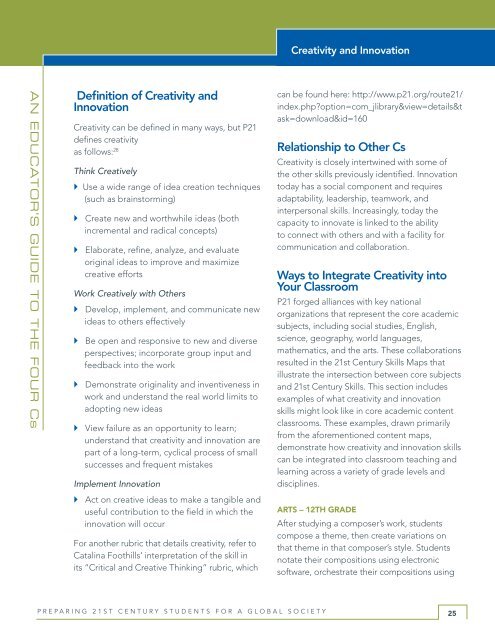Preparing 21st Century Students for a Global Society
Preparing 21st Century Students for a Global Society
Preparing 21st Century Students for a Global Society
You also want an ePaper? Increase the reach of your titles
YUMPU automatically turns print PDFs into web optimized ePapers that Google loves.
An EducAtor’s GuidE to thE Four cs<br />
Definition of Creativity and<br />
Innovation<br />
Creativity can be defined in many ways, but P21<br />
defines creativity<br />
as follows: 28<br />
Think Creatively<br />
``Use a wide range of idea creation techniques<br />
(such as brainstorming)<br />
` `Create<br />
new and worthwhile ideas (both<br />
incremental and radical concepts)<br />
` `Elaborate,<br />
refine, analyze, and evaluate<br />
original ideas to improve and maximize<br />
creative ef<strong>for</strong>ts<br />
Work Creatively with Others<br />
` `Develop,<br />
implement, and communicate new<br />
ideas to others effectively<br />
` `Be<br />
open and responsive to new and diverse<br />
perspectives; incorporate group input and<br />
feedback into the work<br />
` `Demonstrate<br />
originality and inventiveness in<br />
work and understand the real world limits to<br />
adopting new ideas<br />
` `View<br />
failure as an opportunity to learn;<br />
understand that creativity and innovation are<br />
part of a long-term, cyclical process of small<br />
successes and frequent mistakes<br />
Implement Innovation<br />
` `Act<br />
on creative ideas to make a tangible and<br />
useful contribution to the field in which the<br />
innovation will occur<br />
For another rubric that details creativity, refer to<br />
Catalina Foothills’ interpretation of the skill in<br />
its “Critical and Creative Thinking” rubric, which<br />
P r e P a r i n g 2 1 s t C e n t u r y s t u d e n t s f o r a g l o b a l s o C i e t y<br />
Creativity and Innovation<br />
can be found here: http://www.p21.org/route21/<br />
index.php?option=com_jlibrary&view=details&t<br />
ask=download&id=160<br />
Relationship to Other Cs<br />
Creativity is closely intertwined with some of<br />
the other skills previously identified. Innovation<br />
today has a social component and requires<br />
adaptability, leadership, teamwork, and<br />
interpersonal skills. Increasingly, today the<br />
capacity to innovate is linked to the ability<br />
to connect with others and with a facility <strong>for</strong><br />
communication and collaboration.<br />
Ways to Integrate Creativity into<br />
Your Classroom<br />
P21 <strong>for</strong>ged alliances with key national<br />
organizations that represent the core academic<br />
subjects, including social studies, English,<br />
science, geography, world languages,<br />
mathematics, and the arts. These collaborations<br />
resulted in the <strong>21st</strong> <strong>Century</strong> Skills Maps that<br />
illustrate the intersection between core subjects<br />
and <strong>21st</strong> <strong>Century</strong> Skills. This section includes<br />
examples of what creativity and innovation<br />
skills might look like in core academic content<br />
classrooms. These examples, drawn primarily<br />
from the a<strong>for</strong>ementioned content maps,<br />
demonstrate how creativity and innovation skills<br />
can be integrated into classroom teaching and<br />
learning across a variety of grade levels and<br />
disciplines.<br />
ARts – 12th GRAdE<br />
After studying a composer’s work, students<br />
compose a theme, then create variations on<br />
that theme in that composer’s style. <strong>Students</strong><br />
notate their compositions using electronic<br />
software, orchestrate their compositions using<br />
25


